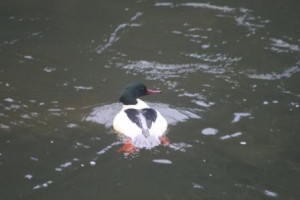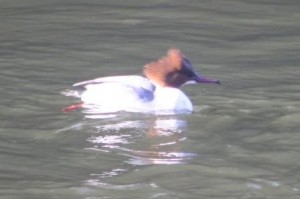Goosing around
The river just outside the Visitor Centre has been a favourite spot for a pair of goosanders recently. Goosanders aren’t actually a type of goose, but are ducks belonging to the sawbill family.

This name comes from how their bills are adapted to deal with the slippery fish they like to eat. Their slender red bills are armed with backwards pointing teeth to ensure they can hold on to their catch.
In fact, their whole appearance reflects their predatory lifestyle. Their long, streamlined bodies are perfect for diving under water, in search of fish up to 15cm long. Beneath the surface, their powerful legs propel them torpedo-like, in pursuit of prey.
On the surface, goosanders cut through the water like sleek navy vessels, scanning the water for fish, or popping their heads under, in the hope of spotting a meal.

Even though the males are the flashy ones, with bright white bodies and dark, glossy, green heads, it’s the females I prefer. They are military grey, with reddish-brown heads, so when they raise the crest on their head, they look like an 80s rock star.
Next time you’re walking by a river, look out for these dapper ducks.
Rhian – Seasonal Ranger
Help protect Scotland’s wildlife
Our work to save Scotland’s wildlife is made possible thanks to the generosity of our members and supporters.
Join today from just £3 a month to help protect the species you love.
Preface
The river just outside the Visitor Centre has been a favourite spot for a pair of goosanders recently. Goosanders aren’t actually a type of goose, but are ducks belonging to …
